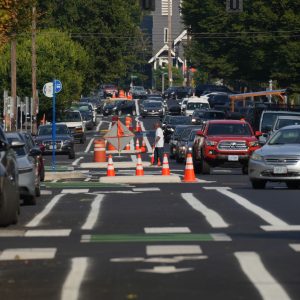I want a new traffic lane.
I want a new traffic lane for my birthday. Well not my birthday, but it would be great to have new lane to celebrate the Oregon Bike Bill. The lanes I want are on the Abernathy Bridge for bicycles, e-bikes, scooters, skateboarders, pedestrians and who are primarily human powered in some manner. We are traffic, too. It seems a fitting tribute to the Bike Bill considering we just dedicated a new sculpture at PSU funded by Oregon Economic Council on Friday, April 26, 2019. Of course, there is a darker side to the un-kept promises of the Bike Bill.
The issue is intertwined in choosing a new ODOT director, the present Active Transportation staff, Metro’s acquisition of Willamette Falls and e-bikes.
We want to increase the power of Active Transportation which has its basis in the promise of the Bike Bill. Sandbagging bike & pedestrian infrastructure doesn’t always come from the top. My concern is the Active Transportation second, third & fourth rungs of ODOT. We need a passion to push the Bicycle/Pedestrian philosophy of the Bike Bill further at all admin levels. A welcomed change would be to have a member of the Oregon Transportation Commission be charged with a specific Active Transportation portfolio of work. We need people in all ODOT positions to lift up people transportation issues in front of a new director and challenge her or him to spend money for moving people first not just single drivers in cars. Viewing ODOT from the outside of its behemoth size and population it is often difficult to know how decisions are crafted.
The Abernathy Example.
In 2016, considerations of bicycle/pedestrians in association with the Abernathy Bridge began to surface in the I-205 Stafford Road Evaluation to increase the seismic resiliency. The project included an extra lane of traffic. Research included facility improvements, consideration of multi-paths, and consideration of bridge options. This document outlines historical AT Plans from Metro, Clackamas, OR City, West Linn, etc. It details the bike – pedestrian assets inventory.
The context summary was “Based on the information summarized in Table 1, if it were feasible, a connection between Clackamette Park and the Arch Bridge in Oregon City to West Linn in the vicinity of the OR 43 /I-205 Interchange could provide an effective link to existing or planned facilities east and west of the existing I-205 Abernethy Bridge.” Presently Bicycles use sharrows only on Rte 43 and pedestrians use bilateral sidewalks.
The balance of the document details bicycle/pedestrian ideas & costs for 1) alternative Abernathy bridge south, 2) new bridge north, 3) Abernathy cantilevered bridges north and south, 4) suspended beneath Abernathy piers-e.g. the noisy I-205, 5) new bridge south of OR 43 and 6) new AT bridge only realigned with OR 43. Scoping costs were ranging from 20 million dollars (new bridge south) to 27 million (cantilever) to 40 million (Widening 205 with multipath), to the largest estimate of 53 million (widening including AT lanes through West Lynn, etc.)
The above shows the Bike Bill’s promise of ODOT’s potential to fulfill the Bike Bill’s directive.
Later in 2016 we jump to ODOT’s I-205 Fastlanes Grant Application: The idea of AT lanes was reduced from detailed solutions to glib opportunity: “Challenge: The Abernethy Bridge is a gap in the regional bicycle and pedestrian mobility network. Today, there are bike lanes on OR 43 to the I-205 on-/off-ramps in West Linn and striped buffered bike lanes on OR 99 in Oregon City, but no straightforward network connection. Solution: This project is an opportunity to provide the much-needed and regionally desired pedestrian and bicycle network connection over the Willamette River between West Linn and Oregon City. Ultimately, this new link will connect to the I-205 Multi-use Path/Clackamas River Trail in Oregon City, providing regional mobility and access to the greater regional trail system.”
A 3rd example of how the Abernathy Project including Active Transportation fell out of view is Clackamas County’s inheritance of information from ODOT. Their Five year Transportation Improvement Program mentions zero about Abernathy Bridge or additional spans across the river.
Back to ODOT. The next I-205 project step details (http://i205corridor.org/project-details) mentions no bicycle or pedestrian facilities. The open house (https://openhouse.oregondot.org/i-205-widening) for I-205 has no details of AT lanes. This absence of any Active Transportation represents the silent tier of ODOT administration at this level in promoting bicycle-pedestrian follow through.
The Abernathy Bike Pedestrian issues became ghosted. I imagine documents entitled, “How to create projects eliminating Bike Bill’s requirements” being circulated at ODOT. This guts the Bike Bill.
Let’s remind ourselves what the second sentence of the bike bill is: Footpaths and bicycle trails, including curb cuts or ramps as part of the project, shall be provided wherever a highway, road or street is being constructed, reconstructed or relocated. (https://www.oregonlaws.org/ors/366.514) Sounds like the Abernathy Bridge to me. Sounded like the St. Johns Bridge several years ago too.
My next two comments have to do with hope.
1) Metro. An improved change of ODOT’s internal vigilance of Active Transportation could happen at several levels by outside forces. I think Metro’s action to acquire the Willamette Falls Legacy Project and subsequent 7 million dollar donation this early April should change the ODOT inaction. This Oregon City incredible tourism resource represents a major regional change. The Willamette Falls is the 17th widest waterfall in the world. Multnomah Falls is the 434th tallest waterfall in the world. Redevelopment of the Oregon City tourism area could be a terrific draw for people coming to Portland. It might even help by drawing visitors away from Multnomah Falls and reducing that congestion due almost 3 million visitors. It is only 13 miles to the Willamette Falls from Portland.
2) The e-bike. An e-bike could easily be used at 15 miles an hour from downtown Portland to Willamette Falls across the Tilikum~down the Springwater~catching a bike lane over to the Abernathy. The return coming back could be on Hwy 43 Bridge~entering Sellwood and the industrial Eastside densely-packed breweries and pubs.
Contrast this great bike ride across several bridges and along a water front with sitting in a car on the Historic Columbia River Highway from 60-90 minutes midday plus waiting for a parking place at Multnomah Falls. The Willamette Falls could be an enormously great and attractive healthy adventure.
I have asked people why don’t they bike places all the past 3 decades. People talk about danger, traffic, deaths, etc. Range Anxiety is a new reason for drawbacks to using bicycles. I have not heard this reason much until lately. This newer reason means people are afraid they will use up all their energy if they bicycle too far away from their starting place. Surprising to me in several testimonials, I heard the solution to range anxiety is an e-bike. I heard this several times in the past two years at the many local and national hearings on e-bicycle use on state and national park trails. I had no idea that this was a hidden-quieter reason people do not bike. And removing the range anxiety unspoken barrier is allowing us to grow our cycling ranks.
It is fascinating to hear e-bike using people say, ‘now I can keep up with him,’ ‘I don’t have to worry about my knees giving out,’ ‘we are sisters meeting here for fun and we never ride bikes, but knew we could get back in time for the bridal rehearsal.’ And even this week I heard a friend who tried an ebike said, “I hate being last on a ride.” And to me this parlays exactly into an economic reason for adding a lane for bike/ped on the Abernathy Bridge. This arterial is long enough for a part of a day trip that a Portland tourist could see an incredible osprey view of the Willamette River and world class waterfall geography.
Metro’s action could wake the ODOT Active Transportation staff as much as we expect a new Director to bring an Active Transportation vision and incorporate the promise of the Bike Bill to all of ODOT. If we continue to have people who have a meek or nonexistent voice about Active Transportation, then no Director will ever engage them to think outside their present lane. The director and staff are a two way street to fulfill the Bike Bill from start to finish of any highway, road or street is being constructed, reconstructed or relocated project.
So Happy Birthday Bike Bill; I know it is a little early but don’t fade. My want is really I need another lane of traffic.
PS (Traffic comes from 16th century romance language variations –traffique-trafico-traffic -meaning merchandise/people transportation)







Thanks for reading.
BikePortland has served this community with independent community journalism since 2005. We rely on subscriptions from readers like you to survive. Your financial support is vital in keeping this valuable resource alive and well.
Please subscribe today to strengthen and expand our work.
Great post AJ!
Foolish me, I can go months without looking in on the subscriber posts. This essay is full of wonderful snippets, valid critical assessments and just my flavor of hope. I really need to check in much more often. Fabulous writing.